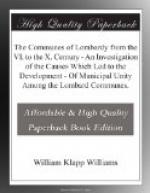The economic condition of the people amounted to little short of bankruptcy; the possession of wealth, in landed property especially, having become but a burden to be avoided, and a source of exaction rather than of satisfaction to the owner. The inequalities of burdens and of rank were great. The citizens were divided into three classes: (1) the privileged classes, (2) the Curials, (3) the common people. The first, freely speaking, were those who had in a manner succeeded in detaching themselves from the interests of the municipium to which they belonged; such were the members of the Senate, including all with the indefinite title of clarissimi, the soldiers, the clergy, the public magistrates as distinguished from the municipal officers. The second consisted of all citizens of a town, whether natives—municipes—or settlers—incolae—who possessed landed property of more than twenty-five jugera, and did not belong to any privileged class: both these classes were hereditary. The third, of all free citizens whose poverty debarred them from belonging to either of the preceding divisions. On the second of these classes, the Curials, fell all the grinding burdens of the state, the executing of municipal duties, and the exactions of the central government.
It is not necessary for me to trace here the development of that financial policy which resulted in the ruin, I may say the annihilation of this order. Suffice it to say that it formed the capital fund of the government which exhausted it, and when the source of supply was destroyed, production ceased, and with it, of course, all means of governmental support. Where the extinction of this “middle class” touches the point of our inquiry is in affording an explanation of a circumstance in the history of the Lombard subjugation of the Italian towns, which without consideration of this fact would appear almost incomprehensible. I refer to the utter passivity of the inhabitants, not only in the matter of resistance to attack, which the greater strength and courage of the invaders perhaps rendered useless, but in what is more surprising, the fact that after the easy conquest was completed, we hear nothing of the manner in which the people adapted themselves to the totally new condition of life and of government to which they were subjected. Even if we can understand hearing nothing of what the people did, at least we should expect to hear what was done with it, what it became. The story of its resistance might be short and soon forgotten, but the story of its sufferings, of its complaints, of struggle against the entire change in the order and character of its life, should be a long one.




